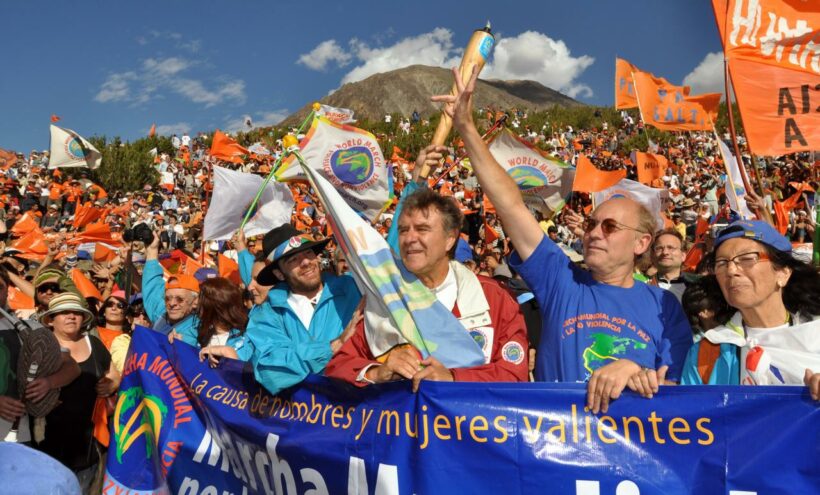Fourteen years ago, on January 2, 2010, the closing ceremony of the First World March for Peace and Nonviolence was held in the mountainous area of Punta de Vacas, a few kilometres from the border between Argentina and Chile.
After covering nearly 200,000 kilometres during 93 days and with hundreds of activities in more than 400 cities in 90 countries, the March culminated its journey in the Punta de Vacas Park of Study and Reflection, the foundational space of the movement initiated by Silo in the 1960s.
Nearly 20,000 people welcomed the members of the base team of the World March from various countries who travelled the globe requesting the cessation of armed conflicts, demilitarisation, nuclear disarmament, the return of occupied territories, the withdrawal of invading troops, progressive and proportional planetary disarmament and the reorientation of absurd military budgets towards human development and social justice.
This is how Pressenza agency described the multitudinous event:
This first World March has been “the largest demonstration on Peace and Nonviolence in history and the first on a planetary scale”, said its organisers. At the event, the activists who travelled the world spreading the campaign’s principles spoke. Rafael De la Rubia began his testimony at 6pm: “This march is a demonstration effect, a foretaste of other great transforming actions of humanity”, said the international spokesperson of this initiative, in his closing speech at the Punta de Vacas Park of Study and Reflection, the same place where it was announced in November 2008, at the Symposium of the World Centre for Humanist Studies.
Hundreds of thousands of people, more than three thousand organisations and a group of almost 100 marchers took part in the march, members of different base teams that made different journeys: intercontinental, Middle East and Balkans and South East Africa. On its journey it passed through more than 400 cities, 90 countries and covered nearly 200,000 kilometres over 93 days.
On their journey through the different countries, they have been received by the UN Secretary General, Ban Ki-Moon, Nobel Prize winners, presidents of governments, parliaments and hundreds of mayors. But the reception has also been popular; two illustrative cases were the almost 80,000 young people who received the Intercontinental Base Team at a music concert in Chile and 12,000 schoolchildren in the Philippines, among many other massive events.
Regarding the day-to-day life of the marchers, some accommodations have been comfortable, others quite austere: Buddhist monasteries, makeshift houses, even in an anti-atomic shelter the marchers have slept. They have had threats of tsunamis, earthquakes, typhoons and marched in temperatures of 40 degrees and below zero.
Along the way, they have encountered people made homeless by typhoons in the Philippines, hibakusha survivors of the Hiroshima bomb, millions of families broken by wars in Korea or Palestine. They have visited numerous memorials to the millions killed in wars in Europe and Asia, places where torture was practised, disputed borders between India and Pakistan, Israel and Palestine, the Balkans, in Tijuana, the US-Mexico border. They have seen children at work in Asia, Africa and America; abused women all over the world. “On the journey we have had everything, moments of great meaning, where the demands of the past converged with the aspirations of the future. Moments of a connection with the people that allowed us to communicate across languages, cultures, races and beliefs,” said De la Rubia at the no end, who is also the coordinator of the World Without Wars association, the organiser of the march.
Gemma Suzara from Filipinas at the event recounted her experience with the March: “I will remember it for the rest of my life… the mega symbol… the mega symbol of the March. the mega symbol of peace with thousands of school children in the Philippines made me think that if we really work as one body and believe in the work as one body and believe in ourselves, we can overcome any limits.
India’s Bhairavi Sagar, who has travelled through India, Europe, Africa and the Americas, explained in her speech “I was born in the country of the father of Nonviolence – Mahatma Gandhi – a man who dedicated his life to make our country free and thanks to whom I am standing here today as a free human being without chains. Now it is my turn to give to future generations, to do my part to leave a world where people can live in dignity and happiness.
Tony Robinson, an Englishman who has travelled to 30 countries, told in a more intimate tone “In Japan we met Hibakusha, of the atomic bomb survivors. One of whom said to us, ‘Thank you, thank you. This is so important!’ I translated these words while trying not to cry because of feelings of such empathy for the terrible suffering this woman had lived through and feeling undeserving of her thanks”.
The words followed and Giorgio Schultze, the March’s spokesperson for Europe and a participant in the Middle East and Balkans teams said: “We passed through the wall of Israel in Palestine and now more than 200 social leaders, former Fatah fighters, are requesting us to form a non-violent army that can communicate and open the doors to reconciliation and start a new history of non-violent coexistence between Palestinians and Jews”.
The event ended with the words of Tomás Hirsch, spokesperson for the World March in Latin America, referring above all to the future of the World March. and referring to the future of the Humanist Movement, the organisation behind the World March.
After 19.30, when the sun was already setting over the mountains of the Andes, the event ended with the greeting of the “Humanist Movement”, the organisation that promoted the World March. Ending with a greeting of “peace, force and joy” from all those present.”
It is obvious that fourteen years after that massive signal from the peoples, the future of peace and nonviolence still seems distant. All the more reason to redouble our efforts to bring it closer.






